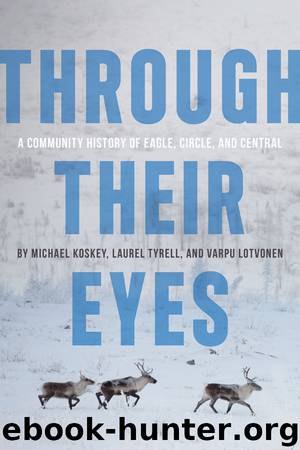Through Their Eyes by Michael Koskey

Author:Michael Koskey
Language: eng
Format: epub
ISBN: 9781602233584
Publisher: University of Alaska Press
Education and the School
Formal education in Circle began when pioneer teacher Anna Fulcomer was sent to Circle after a town meeting held in January of 1896, resulting in a petition being sent to the Department of Education (Gates 1994, 120–121). The people of Circle were to provide the schoolhouse and furniture while the Bureau of Education in Washington provided the teacher and her salary, lamp oil, and wood as heating fuel. When Fulcomer arrived, the school was not completed. She began classes with thirty to thirty-six students amidst the construction. There was a mixture of people, including both settlers and Alaska Natives of various backgrounds, from ages five to thirty (Gates 1994, 122).
Nels Rasmussen donated a building to the Territorial School in Circle. He had been operating a saloon in the building since 1910, but when local alcohol prohibition came along in 1918 (national prohibition came into law in 1920), he gave it to the territory to use as a school. It was moved to higher ground, ideally out of the spring flooding zone, where it became a school. Sometime between 1918 and 1919, the Native School burned to the ground and all students then attended the Territorial School in the old saloon. During this time, official policy dictated the separation of Alaska Natives from non-Natives for schooling, so this mixed situation was atypical and temporary.
As was noted in the chapter on Eagle, there were years when the prevailing philosophy of education was to assimilate Alaska Native children into the settler population. In order to accomplish this task, English was the only language allowed while attending school. Larry Nathaniel, a long-term resident of Circle whose family was from Chalkyitsik on the Black River to the northeast, spoke of his experiences while attending a school where he was forbidden to speak his native tongue. Feeling sorry for the younger children, who could not comprehend what the teacher was asking them to do, he would translate for them even though he knew he would be punished for this act of kindness.
In more recent times, in accordance with the Regional Educational Attendance Area (REAA), which had jurisdiction over the school system of Circle and Central, the local people served by the schools could be elected to the board and make decisions on how education was to be carried out. Albert served on the Yukon Flats School District Board of Education. With the advent of this local control, Albert could help to facilitate the emergence of the bilingual program that would teach the young people not only their native language but their customs and traditions as well, within the school’s educational programs.
Albert also valued people who had a formal Western education and was outspoken about his own lack thereof. During the summer of 1979, he was piloting the Brainstorm up and down the Yukon River and hired a cook to supply meals for him and his two deckhands. The young tourist to whom he offered the job had just arrived in the area. During
Download
This site does not store any files on its server. We only index and link to content provided by other sites. Please contact the content providers to delete copyright contents if any and email us, we'll remove relevant links or contents immediately.
| Africa | Americas |
| Arctic & Antarctica | Asia |
| Australia & Oceania | Europe |
| Middle East | Russia |
| United States | World |
| Ancient Civilizations | Military |
| Historical Study & Educational Resources |
The Body: A Guide for Occupants by Bill Bryson(5025)
Liar's Poker by Michael Lewis(3410)
Into Thin Air by Jon Krakauer(3346)
Tuesdays With Morrie by Mitch Albom(2722)
Into the Wild by Jon Krakauer(2604)
The Diamond Cutter by Geshe Michael Roach(2036)
My Dark Places by James Ellroy(1906)
Columbine by Dave Cullen(1839)
Helter Skelter: The True Story of the Manson Murders by Vincent Bugliosi & Curt Gentry(1711)
Extraordinary, Ordinary People by Condoleezza Rice(1481)
Everything in Its Place by Oliver Sacks(1467)
Pilgrim at Tinker Creek by Annie Dillard(1406)
Into the wild by Jon Krakauer(1400)
You Can't Touch My Hair by Phoebe Robinson(1383)
The Girls: Sappho Goes to Hollywood by Diana McLellan(1297)
Dark Towers by David Enrich(1229)
Betrayal by Gregg Olsen(1217)
Call Sign Chaos by Jim Mattis & Bing West(1202)
Remedy and Reaction by Paul Starr(1169)
